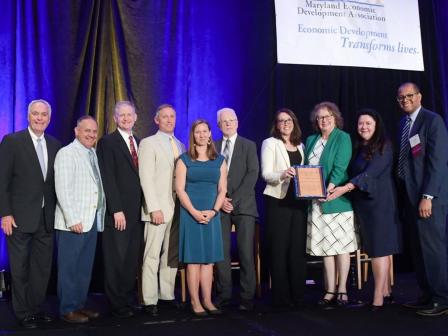
Maryland EDD Helps Eastern Shore Businesses Navigate the Pandemic
With just two employees, the Mid-Shore Regional Council (MSRC) may be among the smallest of EDA’s economic development districts. But by leveraging the strength of its regional partners, the MSRC makes an enormous impact on Maryland’s Eastern Shore.
Founded in 2001, this council operates as a regional planning and development agency between three Maryland counties – Caroline, Dorchester, and Talbot. The goal: to foster physical, economic, and social development in the region.
That mission was put to the test at the onset of the coronavirus pandemic early in 2020. With COVID-19 cases rising and businesses in lockdown, the counties on the Eastern Shore of the Chesapeake Bay struggled to support local businesses and the people they employed.
To aid in the COVID-19 response, MSRC created the Eastern Shore Economic Recovery Project, turning to long-time partner EDA for financial support.
“When the CARES Act was announced in 2020, we thought we’d get $40,000 to $50,000 in EDA funding,” said Scott Warner, MSRC Executive Director. “We were pleasantly surprised when EDA awarded $400,000 for this project.”
The first order of business was to assemble the team. Rather than hire a consultant, Warner turned to his regional partners. The Tri-County Council of the Lower Eastern Shore of Maryland brought manpower and an additional $107,000 of EDA funding. The Mid-Shore economic development offices in Caroline, Dorchester, and Talbot counties provided additional resources, while leaders of the Upper Shore Workforce Investment Board and the Lower Shore Workforce Alliance both signed on.
Warner rounded out the team with data scientists from the Eastern Shore Regional GIS Cooperative, creators of the well-known Delmarva Index. These were the people who could take economic data and, using the cutting-edge technology at their disposal, create data maps and dashboards that would make the information easy to understand so the team could best respond to the needs of the business community.
The group started with 31 different ideas for tools that could be developed. Ultimately, they winnowed the list down to four, the first of which was a web portal that houses all of the tools and offers easy access to key economic indicators. Data visualizations include interactive dashboards, web mapping applications, interactive reports, key points, and summaries.
Other tools include original tax revenue dashboards built with data collected by the Maryland Comptroller’s Office. Dashboards show tax collections across years, county boundaries, and industries. Data visualizations correspond with charts showing COVID-19 cases and the influx of federal economic stimulus. A final dashboard shows the deep impact of the pandemic on the hospitality industry.
To create a regional survey to gauge business sentiment, the group worked with Salisbury University’s Business Economic and Community Outreach Network (BEACON). The 50-question survey was administered first by the economic development offices in Caroline, Dorchester, and Talbot counties. All nine counties on Maryland’s Eastern Shore deployed the most recent survey that ended in June 2022.
“Our team came up with about 50 questions, which we tweaked, and eventually narrowed down to the final survey, which was targeted at business managers,” said Warner. “We took all of that data and created a database for each question, which is now easily accessible for businesses looking for the path forward. The data will also be used to present feedback to councils and businesses in the form of dashboards, infographics, and summary reports.”
Together, these tools provide free, easy-to-use economic data for making decisions in crisis situations. Economic development directors and their boards, as well as elected officials, now have a reliable way to gauge the impact of an economic crisis and the corresponding recovery. The tools will be maintained by the GIS cooperative and are now a permanent part of the Delmarva Index.
Each economic development office has launched its own public outreach initiative to share the tools with stakeholders and the public, to effectively illustrate how MSRC is working to build economic resilience within the community. Tailored for each municipality, these included an in-person symposium for local business leaders, presentations on the various dashboards, and a short educational video featuring the economic development directors from each county.
Looking ahead, the State of Maryland Department of Commerce has received funding to expand the project, creating similar dashboards for other regions across the state. Warner hopes to present the finished projects to Maryland representatives on Capitol Hill and to his colleagues at EDA.
“The committee is proud of our partnership and the tools we created,” Warner says. “We are working together to provide real economic change in the three counties we represent to build a stronger and more resilient state of Maryland.”
